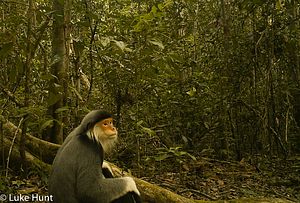Way out on the remote borders that divide Cambodia, Laos and Vietnam sits the Virachey National Park (VNP), one of the last bastions for endangered Indochinese wildlife and the focus of scientific attention for groups like HabitatID.
Greg McCann, a field coordinator with HabitatID, said his latest field trip into the region to retrieve photos from a batch of 21 camera traps hidden in the forests had been a success, with his finds countering arguments that the park had been poached into an “empty forest.”
Twenty-five different species of mammals and six species of birds were photographed – among them gibbons and hornbills – which he said were indicators of a healthy forest, along with evidence of elephants, leopard cat, gaur, the duoc langur, and sun bears.
That is a rare victory for environmentalists. Nearly all of Vietnam’s wildlife has been poached out of existence. Deforestation rates in Cambodia are among the highest in the world while jungles in Laos are coming under increased pressure from massive infrastructure projects such as dams.
Endangered animal parts can be found in the markets of Phnom Penh, Vientiane and Hanoi.
McCann said Virachey’s size, covering 3,325 sq km, and location made it difficult to patrol.
“The Vietnamese, however, are undaunted by such logistics and they will roam as far as necessary to look for things like the Mreah Prew tree from which sassafras oil is used to make ecstasy.
“They are also combing the park for rosewood trees, gold, and anything else they can convert to cash. The VNP rangers are doing their best to stop them along the Park’s border with Vietnam.”
There were also false alarms, including a photograph of a what many thought was a baby tiger.
Senior environmentalists recently said the Indochina tiger is now extinct in Vietnam, Cambodia and Laos and functionally extinct – meaning their numbers are too small to support future generations – in China. Any proof to the contrary would have set the scientific world alight.
“We were three days deep into the trek and we were checking the memory card in our camera which in the past yielded sun bear, stump-tailed macaques, and other animals.
“I clicked through the photos and stopped at what appeared to be a baby tiger. It looked stripy, orange, and had single white spots on the back of the ears – just like a tiger.”
He said local porters supported this view but the animal was far from the camera and the shot was taken from a back angle, so the image was not great. After closer inspection, McCann now believes the photo was of a leopard cat.
There are just 3,200 tigers left, roaming wild in the forests of the remaining nine tiger countries – India, Nepal, Bhutan, Bangladesh, Myanmar, Thailand, Malaysia, Russia and Indonesia.
Conservationists and scientists say demand for traditional medicine in China remains a chief cause for their demise, along with many other mammals that are still being found in the Virachey National Park. McCann says the park enjoys some protection because of its remoteness and rugged mountains. There is another factor: the spiritual beliefs held by the local Brao, Kreung and Kavet people who live along the Sesan River.
“Many will not hunt or log on those mountains for fear of the spirits: There is a kind of animistic conservation at work there,” McCann said. “The border mountains are so remote, big, beautiful, and still so thoroughly covered in forest that it is possible to believe that tigers and tek teks still cling to existence there.”
Luke Hunt can be followed on Twitter @lukeanthonyhunt

































